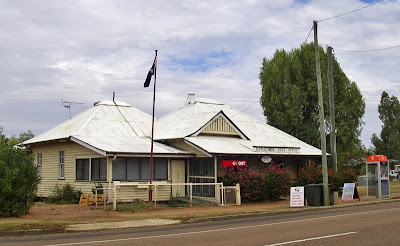On the way ...someone just couldn't resist it!
Today's destination is Longreach, but as we have found, some towns just can't be missed and en route we arrived in Ilfracombe. Here the pronunciation rhymes with 'hair-comb', somehow the Devonian 'coome' has fallen away.
Ilfracombe's main industry is sheep rearing, mainly for wool. It is also the home of a collection of antique agricultural machinery called 'The Machinery Mile'. At the 2006 census, Ilfracombe and the surrounding had a population of 269, and we think all of them had been involved in keeping the town looking smart.
Here are a few shots of Ilfracombe's features. The first one has an extensive explanation, but the rest are just briefly named (it at all). (We have to catch up!)
The Langenbaker House and its contents provide excellent insights into the lives of Ilfracombe's pioneers. It is preserved by the local comunity as a reminder of the circumstances of life in earlier days in the town and as a memorial to previous generations of townspeople.
It is a good example of the kind of housing which was once typical in outback towns. Like so many of Ilfracombe's early buildings, the house was orignally built in a town further east along the railway line from Rockhampton. The house and the Langenbaker family moved west with the railway line.
Harry Langenbaker and his wife Mary Ann brought the house to Infracombe in about 1899. From there Harry plied his trade as a teamster specialising in carrying wool and station supplies between the Ilfracombe railhead and pastoral station far to the south along the Barcoo River. Mary Ann lived here until her death in February 1964. The couple raised eleven children in the house, the youngest of them Bernard died here in 1991.
The metal lattice work which screen the front and rear verands is a feature once common in the town - the lattice was recycled from hoop iron straps which once bound the bundles of wool packs which wre used at the Ilfracombe wool scour.
 The General Store
The General Store The Wellshot Hotel
The Wellshot Hotel Old Post Office - still functioning!
Old Post Office - still functioning!
Now - on to Longreach.
Longreach is approximately 700 kilometres from the coast, west of Rockhampton. It is named after the 'long reach' of the Thomson River on which it is situated and was gazetted a town in 1887. In 1892, the railway reached the town, and the population began to grow.
The town lies on the Tropic of Capricorn with a population of 2,976.
...and has some nice examples of Art Deco building.
The main industries of the area are cattle, sheep, and, more recently, tourism.


The town is home to the Australian Agricultural College and to the Longreach School of Distance Education, which provides lessons to remote students, formerly by UHF radio, but now using telephone lines. There are several Schools of the Air, but this one covers an area of about 400,000 sq. kms. Almost twice the size of Britain.
Longreach was one of the founding centres for the Australian domestic and international airline, Qantas.

One of the airline's original hangars remains in use at the Longreach Airport. The town is now the home of the Qantas Founders Outback Museum, which includes amongst its displays a decommissioned Qantas Boeing 747-200 aircraft, registration VH-EBQ, "The City of Bunbury." Now, I would assert that we are not 'mean' folks, but as the entry to the museum (including a walk on the wing of a 747) was set at $130 each, we gave it a miss!
Longreach is also the home of the Australian Stockman's Hall of Fame.
We were entertained by a stockman turned demonstrator/humourist.
The displays in the Hall of Fame were splendidly arranged and there was a wide collection of memorabilia, photos and historical information.
In the evening at the camp kitchen, an Outback Poet entertained with poems and tales of days gone by.
A wedding party being conveyed in a replica Cobb & Co carriage.










.jpg)


.jpg)


No comments:
Post a Comment